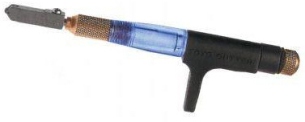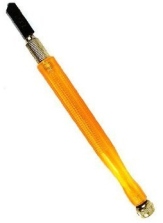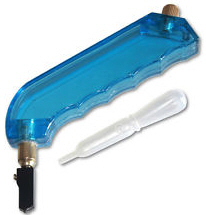In the Middle Ages glass was cut with a heated and sharply pointed iron rod. The red hot point was drawn along the moistened surface of the glass causing it to snap apart; due to the thermal shock created by the heat and the water. The Medieval glaziers were exposed to a high risk of burns as well as glass cuts.
Fractures created in this way were not very accurate and the rough pieces had to be chipped or “grozed” down to more exact shapes with a hooked tool called a grozing iron. Despite this risky and labor intensive process for the commission stained glass windows and panels, beautiful stained glass from this period still survives and can be seen in our Cathedrals and churches.
Between the 14th and 16th centuries, starting in Italy, a diamond-tipped cutter became prevalent which allowed for more precise cutting. Then in 1869 the wheel cutter was developed by Samuel Monce of Bristol, Connecticut, which remains the current standard tool for most glass cutting.
Tungsten wheel cutters were widely used and then the carbide wheel came along. Oil filled Carbide wheel cutters are the most popular today and come in a variety of designs. The carbide wheel glides easily along the glass and does not actually require oil to improve its score or prolong its life; however the reservoir that holds the oil makes a very comfortable handle!
The Toyo Custom Grip Cutter
The custom grip is short with a saddle to be held between the thumb and the index finger. The saddle is adjustable to four different heights. Exclusive to this design is the revolutionary “tap wheel” adjustment. The wheel has eight cams which create taps on the wheel as you score, allowing the wheel to cut deeper into the glass. It requires less pressure to use, prolongs the life of the wheel, and makes for a better score.

Toyo Thomas Grip Cutter
This cutter is smaller than the Custom Grip. It also has a saddle. Your index finger rests squarely on the head. Thomas Grip features a swivel head and is easy to guide. The cutter is good for people with less strength in their wrists and fingers.

Pencil Grip Cutters
This cutter has a straight shaft which can be held like a pencil. Quite a lot of pressure is needed to score some types of glass. I find that holding the stem at the lowest point can help. It can be hard on the hands if the user is not particularly strong in this area.

Pistol Grip Cutters
There are many makes of this style on the market now. First manufactured by Toyo, this glass cutter features a hollow pistol – like grip which can be filled with lubricating oil (not really necessary) but it makes a very comfortable gripable handle. It puts less strain on the wrists and is a very popular cutter.
This is my preferred cutter, I can use it every day for the entire detailed and strait lined glass cutting that I do. I never have to worry about hand, arm or shoulder pain. It makes the whole process much easier for me. The majority of my students both male and female prefer this cutter too.

A selection of glass cutters are available from the following the list of stained glass equipment suppliers. However there are many more. It can be worthwhile to shop around for the best deal.
Lead & Light | The stained glass specialist in the heart of Camden

